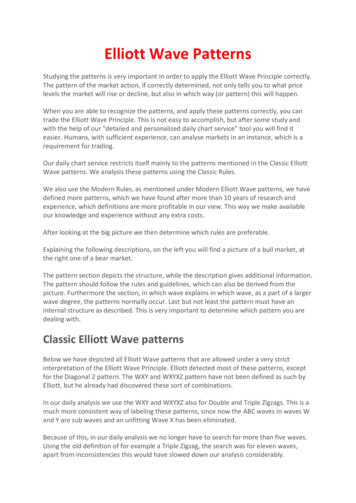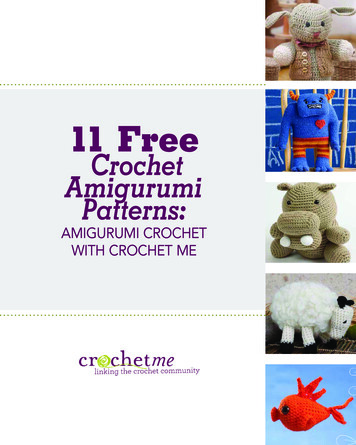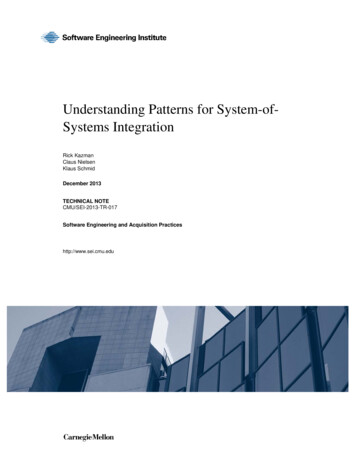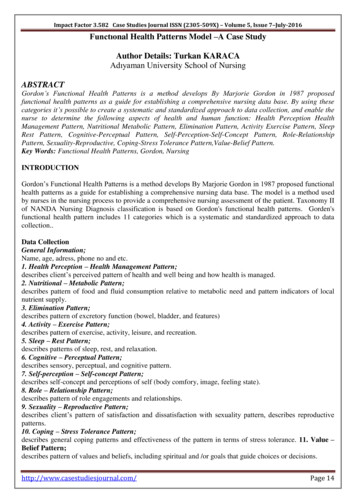
Transcription
Cozy KnittedBlanket Patterns:7 FreeAfghan KnittingPatternsfrom
Cozy Knitted Blanket Patterns:7 Free Afghan Knitting PatternsNOW’S THE TIME OF YEAR TO GET COZY UNDERA KNITTED BLANKET, so we’ve gathered seven free afghanpatterns for you!Tamarix Quilt: Heather Zoppetti’s beautiful knit quilt makes awonderful baby blanket or a pretty throw to brighten your décor.River and Woods Afghan: Hana Jason’s highly texturedentrelac afghan is dotted with cables and punctuated with tasselson the corners.Southern Cross Afghan: This color-blocked blanket beginswith 13 mitered triangles. A knitted-on garter-stitch borderbrings Ann McDonald Kelly’s blanket all together.Yggdrasil Afghan: Lisa Jacobs’ afghan is a stunner: Intricatecable patterns, a bit of leaf lace, multi-directional knitting, andthoughtful heritage inspiration combine for a blanket worthkeeping out year-round.Frost Flower Afghan: This airy afghan, developed by theInterweave Knits staff, is worked in three separate panels. It’s aversatile afghan pattern—you can change the length and widthof the panels to make the blanket any size you want.Graphic Afghan: Sarah Fama’s afghan is worked in bulky woolwith a geometric knit and purl chevron pattern. This reversibleblanket knits up quick and will grace your sofa for years to come.Mosaic Tile Afghan: Judith L. Swartz’s afghan is a beautifulgathering of individual squares sewn together to suggest a mosaictile wall.I hope one of these afghans will fit into your décor!Cheers,Kathleen CubleyEditor, KnittingDaily.comContents1 Tamarix Quilt by Heather Zoppetti. PAGE 32 River and Woods Afghan by Hana Jason. PAGE 73 Southern Cross Afghan by Ann McDonald Kelly. PAGE 114 Yggdrasil Afghan by Lisa Jacobs. PAGE 15COZY KNITTED BLANKETPATTERNS: 7 FREE AFGHANKNITTING PATTERNSA Knitting Daily eBook edited byKathleen CubleyE D I T O R I A L S TA F FCREATIVE SERVICES6 Graphic Afghan by Sarah Fama. PAGE 227 Mosaic Tile Afghan by Judith L. Swartz. PAGE 24Glossary. PAGE 27Janice TapiaAs notedGayle FordPRODUCTION DESIGNERPHOTOGRAPHYILLUSTRATION5 Frost Flower Afghan by Knits Design Team. PAGE 20Kathleen CubleyEDITOR, KNITTING DAILYProjects and information are for inspirationand personal use only. Interweave Knits andKnitting Daily do not recommend, approve,or endorse any of the advertisers, p roducts,services, or views advertised in this publication.Nor does Knits or Knitting Daily evaluatethe advertisers’ claims in any way. You should,therefore, use your own judgment in e valu atingthe advertisers, products, services, and views advertised in Knits or Knitting Daily. F W Media, Inc. All rights reserved F W Media grants permission for any or all pages in this issue to be copied for personal use www.knittingdaily.com2
TamarixQuiltHeatherZoppettiKathryn MartinOriginally publishedin Interweave Knits,Fall 2010 F W Media, Inc. All rights reserved F W Media grants permission for any or all pages in this issue to be copied for personal use www.knittingdaily.com3
Row 1: (WS) K39.Row 2: Sl 1, k17, [sl 1 kwise] 2 times, k1,p2sso, k18—37 sts rem.Row 3 and all WS rows: Sl 1, knit to end.Row 4: Sl 1, k16, [sl 1 kwise] 2 times, k1,Tamarix QuilTHeather ZoppettiFinished Size 36" wide and 36" long.Yarn Brown Sheep Serendipity Tweed(60% cotton, 40% wool; 210 yd [192 m]/100 g): #ST04 yellow buttercup and#ST88 chocolate lily, 3 skeins each; #ST16variegated ivy and #ST08 sunflower, 2skeins each.Needles Squares—size 7 (4.5 mm):straight. Edging—size 8 (5 mm): straightor double-pointed (dpn). Adjust needlesize if necessary to obtain the correctgauge.Notions Tapestry needle; small amountof waste yarn for provisional CO.Gauge 22 sts and 44 rows 4" in garter ston smaller needles.NoteSsquare is knitted with a slipped Eachstitch along both left and right sides. This edge is used for seaming or as thejoining “held stitch” in seaming as yougo.The knitted cast-on allows for a combination of cast-on and pick-up-and-knitmethods for seaming as you go. If youchoose to sew squares together in theend, you may use any cast-on method.Weave in the ends as you knit bycatching them as for floats in strandedknitting. This will reduce the numberof ends per square from four to one.Stitch GuideMitered Square:With MC, smaller needles, and the knittedmethod (see Glossary), CO 39 sts.p2sso, k17—35 sts rem.Row 6: Sl 1, k15, [sl 1 kwise] 2 times, k1,p2sso, k16—33 sts rem.Row 8: Sl 1, k14, [sl 1 kwise] 2 times, k1,p2sso, k15—31 sts rem.Row 10: Sl 1, k13, [sl 1 kwise] 2 times, k1,p2sso, k14—29 sts rem.Row 12: Sl 1, k12, [sl 1 kwise] 2 times, k1,p2sso, k13—27 sts rem.Row 14: Sl 1, k11, [sl 1 kwise] 2 times, k1,p2sso, k12—25 sts rem.Row 16: Sl 1, k10, [sl 1 kwise] 2 times, k1,p2sso, k11—23 sts rem.Change to CC.Row 18: Sl 1, k9, [sl 1 kwise] 2 times, k1,p2sso, k10—21 sts rem.Row 20: Sl 1, k8, [sl 1 kwise] 2 times, k1,p2sso, k9—19 sts rem.Row 22: Sl 1, k7, [sl 1 kwise] 2 times, k1,p2sso, k8—17 sts rem.Row 24: Sl 1, k6, [sl 1 kwise] 2 times, k1,p2sso, k7—15 sts rem.Row 26: Sl 1, k5, [sl 1 kwise] 2 times, k1,p2sso, k6—13 sts rem.Row 28: Sl 1, k4, [sl 1 kwise] 2 times, k1,p2sso, k5—11 sts rem.Row 30: Sl 1, k3, [sl 1 kwise] 2 times, k1,p2sso, k4—9 sts rem.Row 32: Sl 1, k2, [sl 1 kwise] 2 times, k1,p2sso, k3—7 sts rem.Row 34: Sl 1, k1, [sl 1 kwise] 2 times, k1,p2sso, k2—5 sts rem.Row 36: Sl 1, [sl 1 kwise] 2 times, k1,p2sso, k1—3 sts rem.After Row 36, cut yarn and draw throughrem 3 sts.needle; k5, sl all sts to left needle] 4 times,**k4, sl 1, pick up and knit in back loop ofone edge st, psso; sl all sts to left needle;rep from ** to end. Remove provisionalCO and place exposed sts onto largerneedle. Graft ends tog using Kitchener st(see Glossary).BlANketMitered squares (make 100 total):Square A (make 14): Using sunflower asMC and chocolate lily as CC, work miteredsquare (see Stitch Guide).Square B (make 14): Use sunflower asMC and variegated ivy as CC.Square C (make 12): Use variegated ivyas MC and yellow buttercup as CC.Square D (make 28): Use chocolate lilyas MC and yellow buttercup as CC.Square e (make 24): Use yellow buttercup as MC and chocolate lily as CC.Square F (make 8): Use yellow buttercupas MC and sunflower as CC.Work all squares in quantities listed eitherseparately, for sewing later, or by joiningthem in rows across length of blanket,seaming as you go (see page 3).FINIShINGFor traditional seaming: Using mat-tress st for garter st (see Glossary) andfoll assembly diagram, sew adjacent edgestog, being careful to line up color changesas charted. For seaming as you go:Each square is joined to blanket whileknitting by picking up and knitting alongedges and by joining on left or right whileknitting. These joining techniques aredescribed on page 3. With variegated ivy,work applied I-cord edging (see StitchGuide). Weave in loose ends. Block lightly,if desired.Applied I-Cord edging: (worked over5 sts)With larger needles and using theinvisible-provisional method (seeGlossary), CO 5 sts. [*K4, sl 1, pick up andknit in back loop of one edge st, psso; slall sts to left needle; rep from * to corner;k5, sl all sts to left needle; k4, sl 1, pick upand knit in corner st, psso, sl all sts to leftHeather Zoppetti currently works as aWeb application programmer but dreamsof fiber and yarn all day. She spends herspare time knitting, spinning, and dabbling in knitwear design. She writes aboutcrafting at www.digitalnabi.com/blog.Tamarix Quilt originally published in Interweave Knits, Fall 2010. Interweave Press LLC. Not to be reprinted. All rights reserved.publishers of Interweave Knits magazine join the online knitting community at KnittingDaily.com F W Media, Inc. All rights reserved F Wgrants permission for any or all pages in this issue to becopiedfor personal /knittingpatternsformoregreat usepatterns!page 24
Seam aS You GoHeather ZoppettiIf you’ll spend many hours knitting each pieceof this blanket, the last thing you’ll want to dois spend additional hours sewing all the piecestogether. An alternative: Seam as you go.Joining each square as you knit rewards youwith a completed project when you cast off thefinal square. As you finish each square, youadd to a growing blanket, rather than a stackof pieces.Traditional modular knitting techniquespick up and knit the beginning of a new squarealong the cast-on edge or selvedge edge of abase square whenever possible.PICk uP AND kNItInsert needle into slipped stitch or cast-on gap(Figure 1); wrap yarn as if to knit; pull yarnback through the stitch or gap and onto theneedle—1 stitch picked up (CO).However, in the Tamarix Quilt, differentsquares are worked in different directions.Some squares cannot be picked up and knitalong a cast-on edge, and some squares needto be joined as they are knit.Unlike picking up and knitting, which isdone once at the beginning of a square, joiningon the left or right is performed at the end ofeach row on the side where the joining is taking place for the length of the square.Note: Though the Tamarix Quilt is workedin garter stitch for reversibility, Figures 2–7show squares worked in stockinette stitch forclarity. In all photographs, the stockinettestitch side is the right side (RS) of the work.JoIN to FINISheD PIeCe oN the leFt(FIGure 2)(rS) Cast on 1 fewer stitch than given ininstructions, then insert left needle from front(RS) to back (WS) into the bottom-right cornerof the square to which the new square will bejoined (this square is to the left of new square);purl this stitch. Insert left needle into firstslipped stitch or cast-on gap from front to back(held stitch); leave this stitch on left needle.This is shown in Figure 4, but is shownpartway up the join.Row 1: (WS) Slip first stitch to right needle(which also holds the picked-up (held) stitchfrom the adjacent square), with yarn held inback. Pull very tightly; you should feel theyarn tightening in the first few stitches. Finishrow in pattern.Figure 1Row 2: (rS) Work in pattern to last stitch;purl last stitch together with held stitch(Figure 3). Insert left needle into next slippedstitch or cast-on gap from front to back; leavestitch on left needle (Figure 4).Repeat Rows 1 and 2 until all left-edgestitches are joined to new square.JoIN to FINISheD PIeCe oN the rIGht(FIGure 5)(RS) Cast-on correct number of stitches.Row 1: (WS) Work in pattern to last stitch;Figure 2Figure 3Figure 4slip last stitch to right needle. Insert leftneedle into first slipped stitch or cast-on gapfrom front (RS) to back (WS) (held stitch).Return slipped stitch to left needle andknit slipped stitch and held stitch togetherthrough the back loops.Row 2: (rS) Insert right needle into nextslipped stitch or cast-on gap from frontto back (Figure 7). Slip first stitch to rightneedle with yarn held in front. Pull verytightly—you should feel the yarn tighteningin the first few stitches; move yarn to backbetween needles. Finish row in pattern.Row 3: (WS) Work in pattern to last stitch;knit last stitch and held stitch togetherthrough the back loops (Figure 6).Repeat Rows 2 and 3 until all right-edgesstitches are joined to new square.CoMBINING teChNIqueSFigure 5Figure 6Figure 7The basic and the advanced techniques canbe used in any combination while knitting asingle square. For example, you may pick upand knit the cast-on edge and join on the left,join both on the left and on the right, etc.Depending on the order in which you knitthe squares, usually one or two edges willbe joined at once. However, poor planningcould result in a hole, requiring you to worka square with all the methods at once. Toprevent this, I suggest knitting the blanketfrom one end to the other in rows.other APPlICAtIoNSSeaming as you go is not only applicable tojoining mitered squares into a blanket. Youmight use it to add a border to a shawl, adda cuff to a sleeve, or even to join the front ofa sweater to the back as you knit. Avoiding seams results in more fluid, less bulkyfabrics—with half the work! F W Media, Inc. All rights reserved F W Media grants permission for any or all pages in this issue to be copied for personal use www.knittingdaily.com5
Assembly DFFDEAAmattress Stitch for Garter StitchLay the two pieces next to each other, right sides facingup. Thread a tapestry needle with a length of yarn at least threetimes as long as the area you are sewing.Step 2: Working from the bottom up, weave the seaming yarnfrom front to back on the bottom corner of one piece and then,from back to front, bring it through the bottom corner on theother piece (Figure 1). Pull the yarn snugly to join the bottomedges.Step 3: Insert the needle from bottom to top into the purl bumpof a side stitch on one side. Bring the needle up through thebottom edge of the slightly higher stitch on the other piece. Continue sewing on alternate sides in this fashion until you finishthe seam (Figure 2). Pull tightly, and the two pieces should joinseamlessly. Weave the yarn end into the seam for a few inches.Step 1:Figure 1Figure 2Place slipknot on left needle ifthere are no established stitches.*With right needle, knit into firststitch (or slipknot) on left needle(Figure 1) and place new stitch Figure 1onto left needle (Figure 2). Repeatfrom *, always knitting into last stitch made.Figure 2invisible (Provisional) Cast-onPlace a loose slipknot onneedle held in your righthand. Hold waste yarn nextto slipknot and around leftthumb; hold working yarnFigure 2Figure 1over left index finger. *Bringneedle forward under wasteyarn, over working yarn, grab a loop of working yarn (Figure 1), thenbring needle to the front, over both yarns, and grab a second loop (Figure 2). Repeat from *. When you’re ready to work in the oppositedirection, pick out waste yarn to expose live stitches.Kitchener StitchStep 1: Bring threaded needle throughfront stitch as if to purl and leavestitch on needle.Step 2: Bring threaded needle throughback stitch as if to knit and leave stitchon needle.Step 3: Bring threaded needle throughfirst front stitch as if to knit and slip this stitch off needle. Bringthreaded needle through next front stitch as if to purl and leavestitch on needle.Step 4: Bring threaded needle through first back stitch as if to purl (asillustrated), slip this stitch off, bring needle through next back stitchas if to knit, leave this stitch on needle.Repeat Steps 3 and 4 until no stitches remain on needles. F W Media, Inc. All rights reserved F W Media grants permission for any or all pages in this issue to be copied for personal use www.knittingdaily.com6Illustrations by Gayle FordKnitted Cast-on
River andWoods AfghanHana JasonAmanda Stevenson LupkeOriginally published in InterweaveKnits Holiday Gifts, 2008 F W Media, Inc. All rights reserved F W Media grants permission for any or all pages in this issue to be copied for personal use www.knittingdaily.com7
River and WoodsAfghanH a n aJ a s o nNotesu Afghan is worked in entrelac. Each “tier” of fabric moves in the direction opposite tothe ones below and above (see diagram). Tiers alternate between plain (stockinette)and cabled (see chart) blocks. New blocks are added as the blanket grows diagonallyfrom first block, then taken away as the blanket approaches the opposite corner.Circular needles are recommended due to the large number of stitches that will be onthe needles while working diagonally across the afghan. Side triangles are not used asin traditional entrelac; instead, the afghan takes advantage of the fabric’s directionalgrowth to create straight edges on all four sides.u Cast on all stitches using the knitted method (see(see pagepage4).10).u Slip the first stitch of every row on all blocks (see first and last stitches shown on chart,outside repeat box).u Yarn is doubled throughout.u Right-side rows are odd-numbered rows for plain blocks and even-numbered rows forcabled blocks.tier 1 (Block 1–1)With yarn doubled, CO 12 sts (see Notes).Work 24 rows in St st, slipping the first stof every row (see Notes), ending with a WSrow.tier 2Block 2–1: With RS facing, yarn doubled,Hana Jason loves blowing knittedtextures out of proportion.Finished size 50" wide and 72" long.Yarn Lion Brand Nature’s Choice OrganicCotton (100% cotton; 103 yd [95 m]/85 g):pistachio, 22 balls for afghan, plus 3 moreballs to make tassels.needles Size 15 (10 mm): two 29" circulars (cir). Adjust needle size if necessary toobtain the correct gauge.notions Size K/101 2 (6.5 mm) crochet hook;large tapestry needle; cable needle (cn).Gauge 8 sts and 12 rows 4" in St stwith yarn doubled.and sts of Block 1–1 on left needle tip, CO12 sts using the knitted method. WorkingBig Rope chart, work RS Set-up row, thenRows 1–24 and at the same time join toBlock 1–1 at end of RS rows as shown onchart (p2tog; last st with next st of Block1–1), ending with a RS row. Block 2–2:With RS facing, pick up and knit 12 stsalong long edge of Block 1–1 (see diagram).Beg with Row 1 of chart (pick-up rowcounts as Set-up row), work as for Block2–1 except work p2 at end of RS rows, asthere is no joining at left-hand edge, ending with a RS row.tier 3Block 3–1: With WS facing and sts ofBlock 2–2 on left needle tip, CO 12 sts.Work 25 rows in St st, joining to Block 2–2as foll: Set-up row: (WS) Purl.RS Rows 1–23: Sl 1, knit to end.WS Rows 2–24: Sl 1, purl to last st, p2tog(last st with next st of Block 2–2). F W Media, Inc. All rights reserved F W Media grants permission for any or all pages in this issue to be copied for personal use www.knittingdaily.com8
Block 3–2: With WS facing, pick up andpurl 12 sts along edge of Block 2–2 (see diagram). Slipping first st of each row, work inSt st, joining to Block 2–1 with p2tog at endof WS rows. Block 3–3: Pick up and purl12 sts along edge of Block 2–1. Working inSt st, purl all sts on WS rows, as there is nojoining on lower edge.doubled, wrap yarn 50 times around aCD case or other large, sturdy, flat object.Insert tail through all wraps at top to tieoff and create hanging loop; cut throughDirection-of-Work DiagramSt sttier 4Block 4–1: Work as for Block 2–1. Blocks4–2 and 4–3: With RS facing, pick up andknit 12 sts across block of previous tier (seediagram; pick-up counts as Set-up row ofchart). Beg with Row 1 of chart, work asfor Block 2–1, joining to blocks of previoustier. Block 4–4: Work as for Block 2–2.tiers 5–7Cont as established, foll diagram, addingone block every tier, until 7 tiers have beenworked, ending with Block 7–7 in St st.all wraps at bottom. Tie off tassel (seephoto); sew one to each corner. Steamblock blanket carefully, straightening edgesas much as -34-15-56-17-714-215-1cablecast on 12 stswork proceeds indirection of arrowjoin with p2togpick upbind off 11 stsleft-HaNd edgeWorking as shown on diagram, BO Block7–7 as foll: K2, *slip sts back to left needle,ssk (see page 4), k1; rep from * until all stsof Block 7–7 have been BO—1 st rem onneedle. Block 8–1: Pick up and knit 11 stsalong side of Block 7–7 (st rem from Block7–7 counts as one of 12 sts for new block).Work Tiers 8–10 as shown, BO sts of Block9–7 as for Block 7–7, ending with Block10–6.Upper edgeWorking as shown on diagram, BO sts ofBlock 10–6 as foll: P2, *slip sts back toleft needle, p2tog, p1; rep from * until allhave been BO—1 st rem on needle. Block11–1: With WS facing, pick up and purl11 sts along side of Block 10–6 (st remfrom Block 10–6 counts as one of 12 sts fornew block). Work as shown through Block15–1. BO rem sts; do not cut yarn.k on RS; p on WSBig Rope Cable Block23p on RS; k on WS21k2tog19p2tog—last st with next stfrom previous blockMP1715purl into front and backloops of st13cast on or pick up 1 stfiNisHiNgsl 1 wyb on RS; sl 1 wyf on WSsc (see page 4) evenly around blanket,working 12 sts in each block edge, joinwith a sl st in first st.page 4)10)inineachRnd 2: Rev sc (see pageeachsc scaround.Fasten off. Tassels: (make 4) With yarnno stitch119Rnd 1: With RS facing and crochet hook,75sl 6 sts onto cn, hold in frontk6, k6 from cn3MPMPMPMP1 WSset-up rowPattern repeat F W Media, Inc. All rights reserved F W Media grants permission for any or all pages in this issue to be copied for personal use www.knittingdaily.com9
ssk DecreaseSlip two stitches knitwise one at atime (Figure 1). Insert point of leftneedle into front of two slippedstitches and knit them togetherthrough back loops with right neeFigure 2dle (Figure 2).Illustrations by Gayle FordFigure 1Knitted Cast-onPlace slipknot on left needle if there are no established stitches.*With right needle, knit into first stitch (or slipknot) on leftneedle (Figure 1) and place new stitch onto left needle (Figure 2). Repeat from *, always knitting into last stitch made.Figure 2Figure 1single Crochet (sc)Figure 1Figure 2Insert hook into a stitch, yarn over hook and draw a loopthrough stitch, yarn over hook (Figure 1) and draw it throughboth loops on hook (Figure 2).Reverse single Crochet (rev sc)Working from left to right, insert crochet hookinto a knit edge stitch, draw up a loop, bringyarn over hook, and draw this loop through theFigure 1 first one. *Insert hook into next stitch to right(Figure 1), draw up a loop, bring yarn over hookagain (Figure 2), and drawthis loop through bothloops on hook (Figure 3).Figure 3Repeat from *.Figure ckk1f&bk2togkwiseLCm(s)MCmmM1M1R (L)pp1f&bp2togpatt(s)pmpssop2ssopwiseRCremreprev St stribrnd(s)RSrev scscskslsl stssksspst(s)St sttbltogWSwybwyfyo***()[]beginning; begin; beginsbetweenbind offcontrasting colorcentimeter(s)cable needlecast oncontinue(s); continuingdecrease(s); decreasingdouble-pointed needle(s)following; followsgram(s)increase(s); increasingknitknit into front and back of same stknit two stitches togetherknitwiseleft crossmarker(s)main colormillimeter(s)make one (increase)make one right (left)purlpurl into front and back of same stpurl two stitches togetherpattern(s)place markerpass slipped stitch overpass two slipped stitches overpurlwiseright crossremain(s); remainingrepeat; repeatingreverse stockinette stitchribbinground(s)right sidereverse single crochetsingle crochetskipslipslip stitch (sl 1 st pwise unless otherwise indicated)slip 1 kwise, slip 1 kwise, k2 sl sts tog tbl (decrease)slip 1 kwise, slip 1 kwise, p2 sl sts tog tbl (decrease)stitch(es)stockinette stitchthrough back looptogetherwrong sidewith yarn in backwith yarn in frontyarn overrepeat starting point (i.e., repeat from *)repeat all instructions between asterisksalternate measurements and/or instructionsinstructions that are to be worked as a group aspecified number of times F W Media, Inc. All rights reserved F W Media grants permission for any or all pages in this issue to be copied for personal use www.knittingdaily.com10
Southern CrossAfghanAnn McDonald KellyHarper Point PhotographyOriginally published in InterweaveKnits Holiday Gifts, 2013 F W Media, Inc. All rights reserved F W Media grants permission for any or all pages in this issue to be copied for personal use www.knittingdaily.com11
sts using the backward-loop method—60sts. Knit 1 WS row. Cont as for Triangle A,beg with Row 1. Set aside 4 Triangle B forsides.SQUARE C (MAKE 5)SOUTHERN CROSSAFGHANAnn McDonald KellyFinished Size 421/2" square.Yarn Valley Yarns Valley Superwash(100% extra fine merino; 97 yd [89 m]/13/4oz[50 g]): #436 wild rose (MC), 9 skeins;#220 black (CC), 10 skeins. Yarn distributed by WEBS.Needles Size 8 (5 mm) straights and 40"circular (cir). Adjust needle size if necessary to obtain the correct gauge.Notions Markers (m); tapestry needle.Gauge 151/2 sts and 32 rows 4" in garterst; one Triangle A measures 11" wide and51/2" tall.?See knittingdaily.com/Glossaryfor terms you don’t know.With MC and RS of one Triangle B facing,long edge at top, pick up and knit 30 stsalong top edge to center point, pm, CO 30sts using the backward-loop method—60sts. Knit 1 WS row. Cont as for TriangleA, beg with Row 1. With MC and RS ofpartial square facing, missing quarter attop, pick up and knit 30 sts along edge ofpreceding triangle to center, pm, pick upand knit 30 sts along rem edge of TriangleB—60 sts. Knit 1 WS row. Cont as forTriangle A, beg with Row 1.ASSEMBLYSee Assembly chart for picked-up andsewn edges.Borders 1–5: With CC, cir needle, andRS facing, pick up and knit 40 sts along 1edge of Square C. Knit 18 rows. BO all sts.Break yarn, leaving a 20" tail for seaming.Rep for rem 4 squares.Border 6: Work border along long edge of1 corner Triangle A.Borders 7 and 8: Work border alongshort edge of Triangle B. Rep for othertriangle.Side Section 1: With RS facing, arrangeTriangle B with border 7 foll by Square Cwith border 4, foll by a Triangle B with noborder. Using tails, sew border of TriangleB to edge of Square C. Then sew border ofSquare C to other Triangle B.Side Section 2: Work as for Side Section1, joining Triangle B with border 8, SquareC with border 5, and Triangle B with noborder.Center Section: With RS facing, arrangecorner Triangle A with border 6 foll by 3Square C with borders 1, 2, and 3 foll bya corner Triangle A with no border. Usingtails, sew all parts tog.Border 9: With CC and RS facing, pick upand knit 60 sts along Side Section 1 as foll:10 sts along each border and 40 sts alongSquare C. Knit 1 WS row.Row 1 (RS) K2tog, knit to last 2 sts,ssk—2 sts dec’d.Row 2 (WS) Knit.Rep Rows 1–2 seven more times—44 stsrem. BO all sts. Break yarn, leaving a 20"tail for seaming.Border 10: Work as for border 9 at opposite corner.Border 11: With CC and RS of Center Section facing, [pick up and knit 10 sts alongborder, 40 sts along Square C] 3 times, and10 sts along rem border—160 sts. Knit 1WS row. Cont as for border 9, beg with RowNOTESbegins with thirteen individual Afghanmitered triangles, nine of which arebuilt upon to form larger trianglesand squares. Knitted-on garter stitchborders are added and pieces are sewninto strips and its final shape.AFGHANTRIANGLE A (MAKE 13)With MC and using the backward-loopmethod, CO 60 sts. Set-up row (RS) K30,place marker (pm), k30. Knit 1 WS row.Row 1 (RS) K2tog, knit to 2 sts before m,ssk, sl m, k2tog, knit to last 2 sts, ssk—4sts dec’d.Row 2 (WS) Knit.Rep Rows 1–2 seven more times—28 stsrem. Break MC. With CC, rep Rows 1–2 sixmore times—4 sts rem. Next row (RS)K2tog, remove m, ssk, then pass first st onright needle over 2nd st—1 st rem. Fastenoff. Set aside 4 triangles for corners.TRIANGLE B (MAKE 9)With MC and RS of one Triangle A facing,long edge at bottom, pick up and knit 30 stsalong side edge to tip of triangle, pm, CO 30 F W Media, Inc. All rights reserved F W Media grants permission for any or all pages in this issue to be copied for personal use www.knittingdaily.com12
Triangle ATriangle BAssemblytop edgingSquare Berdbo1r1erderdboside edgingside edgingbor8deorCknittingdirectionCCOr9erdbopick up stsr3r4deordeorbbAsewABbottom edging1—144 sts rem. BO all sts.Border 12: Work as for border 11 alongother side of Center Section.Sew all rem parts tog foll diagram.Side edgings: Pick up and knit 30 stsalong corner Triangle A, 14 sts along border, 60 sts along Triangle B, 14 sts alongborder, and 30 sts along corner TriangleA—148 sts. Knit 17 rows. BO all sts.Top and bottom edgings: Pick up andknit 10 sts along side edging, 30 sts alongcorner Triangle A, 14 sts along border, 60sts along Triangle B, 14 sts along border,30 sts along corner Triangle A, and 10 stsalong border—168 sts. Knit 17 rows. BOall sts.FINISHINGWeave in ends. Block to measurements.Ann McDonald Kelly was taught to knit byher Danish mother at the age of five, and shehasn’t stopped yet! She can be found teachingclasses and stocking shelves at the BlackSheep Yarn Shop in Cockeysville, Maryland. F W Media, Inc. All rights reserved F W Media grants permission for any or all pages in this issue to be copied for personal use www.knittingdaily.com13
kk1f&bbeginning; begin; beginsbetweenbind offcontrasting colorcentimeter(s)cable needlecast oncontinue(s); continuingdecrease(s); decreasingdouble-pointed needle(s)following; followsgram(s)increase(s); increasingknitknit into front and back ofsame stk2togknit two stitches togetherkwiseknitwiseLCleft crossm(s)marker(s)MCmain colormmmillimeter(s)M1make one (increase)M1R (L) make one right (left)ppurlp1f&bpurl into front and back ofsame stp2togpurl two stitches togetherpatt(s) pattern(s)pmplace markerpssopass slipped stitch overp2ssopass two slipped stitchesoverpwisepurlwiseRCright crossremreprev St stribrnd(s)RSrev scscskslsl stssksspst(s)St sttbltogWSwybwyfyo***()[]remain(s); remainingrepeat; repeatingreverse stockinette stitchribbinground(s)right sidereverse single crochetsingle crochetskipslip Discover knitwear designs that willslip stitch (sl 1 st pwiseyour imagination.unlesscaptureotherwise indicated)slip 1 kwise, slip 1 kwise,Youtogdon’thave to be a designer or a knitting pro to makek2 sl ststbl (decrease)slip 1beautifulkwise, slip 1knittedkwise, p2garments and accessories, and you don’tsl sts tog tbl (decrease)have to hunt all over for inspiring designs.stitch(es)stockinette stitchFrom cover to cover, Interweave Knits magazine gives youthrough back loopgreat projects, from the beginnerI N toTtheE advanced.R W EEveryA V Etogetherwrongissue
A KNITTED BLANKET, so we’ve gathered seven free afghan patterns for you! Tamarix Quilt: Heather Zoppetti’s beautiful knit quilt makes a wonderful baby blanket or a pretty throw to brighten your décor. River and Woods Afghan: Hana Jason’s highly textured entrelac afghan is dotte










